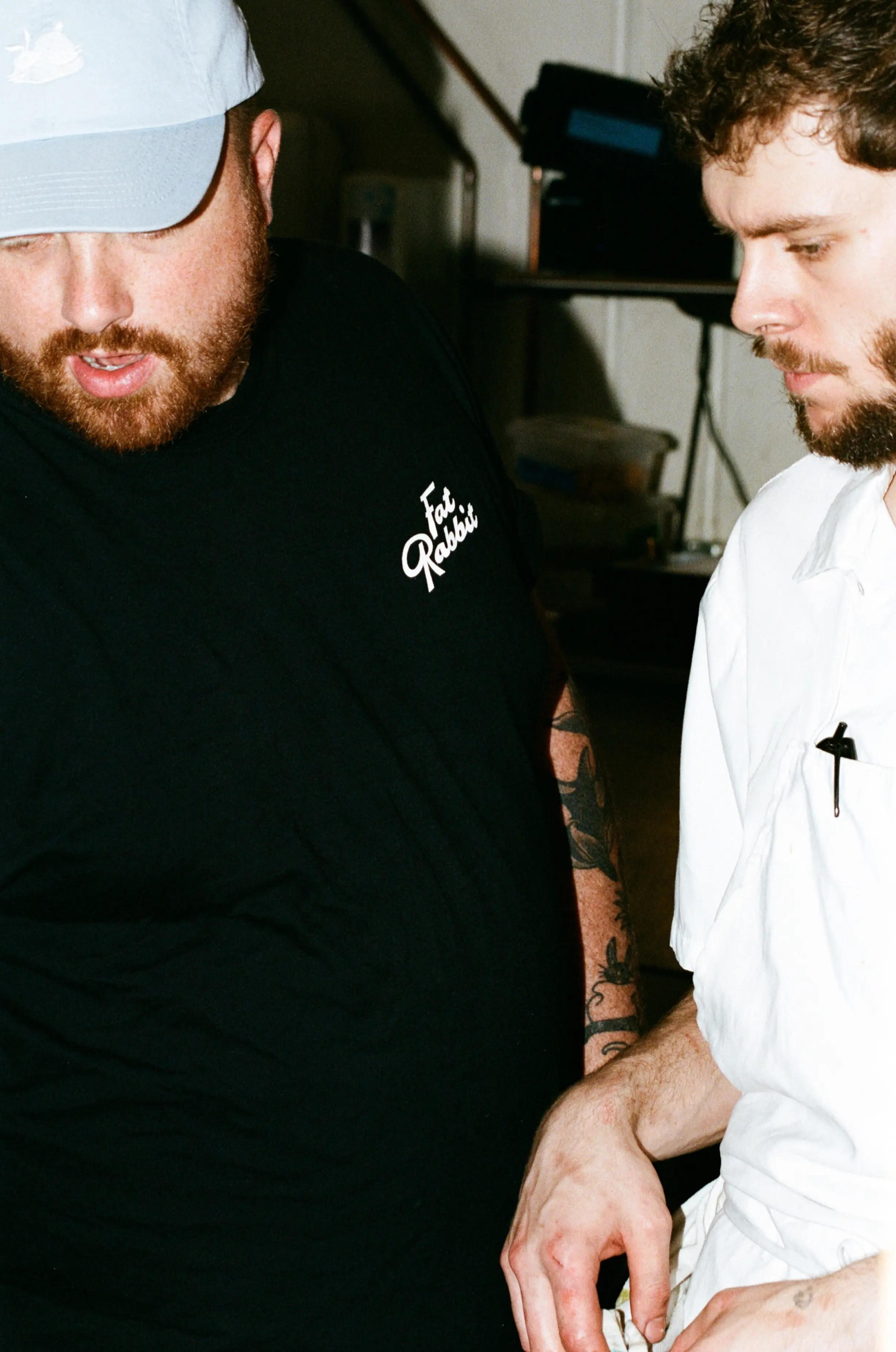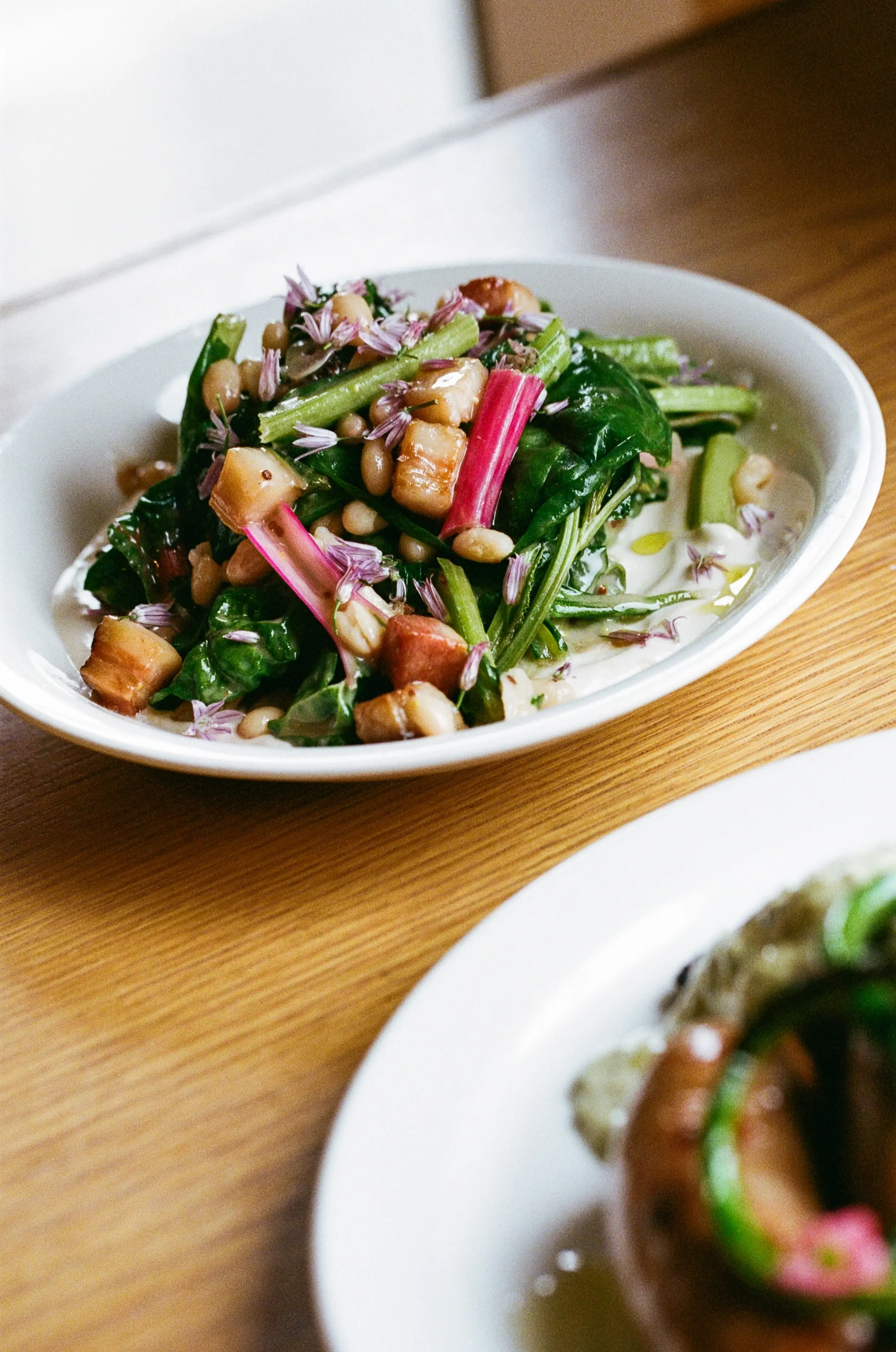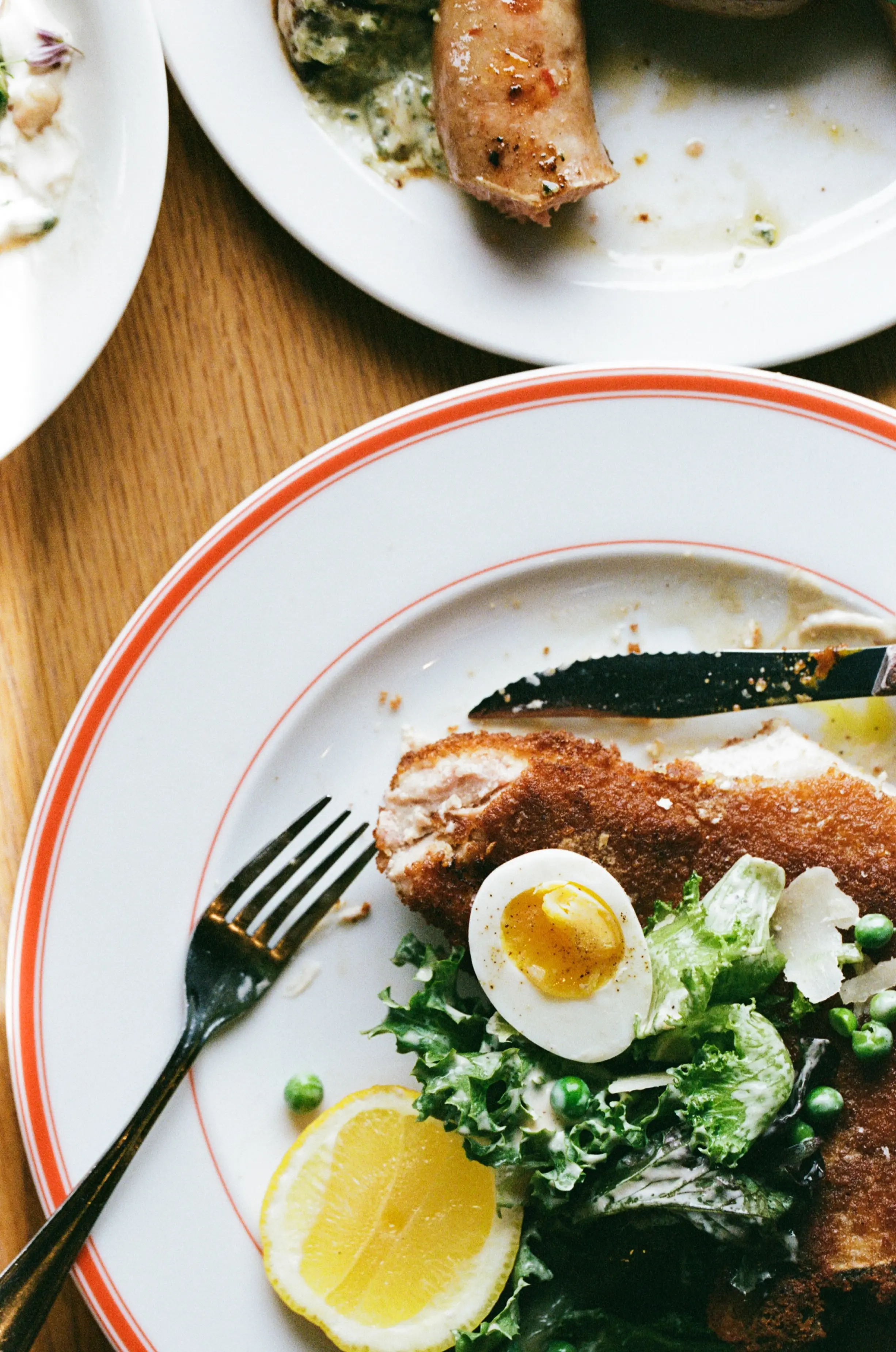On a brisk morning in St. Catharines, chef and restaurateur Zach Smith is taking this call from the front seat of his car, shuttling between Fat Rabbit and the team’s soon-to-open second venture. A broken vac-pack machine has pulled him off recipe testing duty, but he doesn’t sound surprised—just amused. “The trials of running an independent business,” he says with a laugh. “You’ve got to be everything all the time.” It’s a fitting snapshot of a chef building two restaurants at once, in a city he’s come to love, determined to reshape Niagara’s dining scene one small, sustainable step at a time.
You’re in your car right now?
⎯⎯⎯I'm just driving back and forth from our other restaurant. I'm supposed to be there recipe testing right now, but the vackpack machine broke at Fat Rabbit. So I had to go and get one and bring it back.
The trials of running an independent business: you've got to be everything all the time.
⎯⎯⎯ That's right. I'm supposed to be baking bread right now and making cocktail sauce.
What's the second location? Is it open yet, or you're still working on it?
⎯⎯⎯ It's going to be a French-ish bar called Les Incompetents. I’m opening it with my friend and partner here at Fat Rabbit, Bee Lim, as well as Owen Walker, Geof Dilon and Adam D’Intino. So there's five of us. Essentially, since Fat Rabbit has only 30-ish seats, we needed something for spillover. We ended up taking the rest of the building we were in which was an old abandoned bathroom fixture warehouse, and reached out to our friends and colleagues to see if they wanted to do a bar with us, and they said yes. We developed the concept, and then we realized that it wasn't going to work in that space, so it just kind of spat us out the same problem that we have at Fat Rabbit. Coincidentally, at that time, a restaurant down the street was closing down, and we were contacted to see if we wanted to take it over, so we jumped at it. We're doing a full redesign, obviously, but all the bones are there. It's gonna be more seafood-focused. The goal is to have it be the complete opposite, which complements Fat Rabbit while still maintaining its own identity.

Right, Fat Rabbit is the land and Les Incompetents is the sea.
⎯⎯⎯ That's right, yeah. Fat Rabbit is kind of a hybrid retail restaurant, and we never really had a strong bar program, so this is going to complement what we're currently doing right now.
And it’s walkable from Fat Rabbit?
⎯⎯⎯ Yeah, you walk there. We're on a street called Geneva that crosses with St. Paul, which is the main drag in downtown St. Catharines.
It's an interesting place to start a restaurant. Do you have any history in St. Catharines?
⎯⎯⎯ No. In my early 20s, I worked my way up in kitchens in Toronto and met my wife while working in restaurants. She just recently came on board to work at Fat Rabbit, running our events program, but this is now our fourth restaurant group that we’ve worked together in. While we were working at Bar Raval, the pandemic happened, and we just had a baby who was six months old and we both got laid off. We didn't really know what was going to happen, and it was obviously very isolating, especially having a young one trapped in your apartment with no family in the city. But my wife is actually from St. Catharines and though we suspected we may end up out this way eventually, the pandemic really sped things up. We've been here for over five years now.
I was gonna say, it's also the center of wine production with a very fertile farming community.
⎯⎯⎯ Yeah, and I think it's very underutilized for that. The agriculture here is so great. We grow some of the best peaches in the world. What a treat every time that season rolls around. A big wine industry here, but also one thing that's kind of overlooked is that there's a huge hospitality community down here in that Niagara College has a really big culinary and hospitality program. I find that a lot of time, people associate the hospitality out here with the wine country and Niagara-on-the-Lake. St. Catharines often gets overlooked. It's a place where a lot of people that I know from the city have connections, whether they have family or they, or somebody they know, went to Brock University. A lot of people have a connection with St. Catharines, but it's never really been a place where anyone has ever said, “Hey, we're gonna go to St. Catharines for the weekend.” St. Catharines has never really been a place where people stop other than to get gas, but it’s so central to all of Niagara and en route to and from the States, so that's what really attracted me as far as coming here.

Was it also an economic decision in terms of space and affordability, and what you could do?
⎯⎯⎯ Absolutely. When I was in Toronto, I'd never really thought owning a restaurant was obtainable for me. Obviously it is, and a lot of my friends in the same position are business owners, but it was definitely a lot riskier being in the city where your rent and the stakes are so excruciatingly high. It’s nice to be able to build something worthwhile that attracts people outside of the city.
You mentioned that you were previously in Toronto working at restaurants like Bar Raval. You could have picked any culinary focus for Fat Rabbit, so why did you choose meat as the centrepiece?
⎯⎯⎯ I've always worked in restaurants where we have cooked a lot of meat. I’ve never really had the opportunity to work so closely with whole animals and learn the traditional techniques of preserving meat, but it's always been a huge passion of mine. I've cured meat at home, but just never had the opportunity to do that on this scale, so when I decided to open my own place, I just chose that path because I hadn't really done it before, and it excited me. That's reason number one. Reason number two: I definitely struggle with the lack of sustainability in the industry, and the negative implications when it comes to the meat industry, specifically in regards to factory farming, overconsumption of animal products, and even asking ourselves if we should eat meat at all. After years of doing my own digging and trying to sort it out in my head, I came to the conclusion that we're never going to fully stop eating meat, so let's try and change the industry from within. I try to educate myself, educate our employees, and educate the community about not only the small benefits of utilizing the whole animal and reducing waste, but also the benefits of working with small farms that are committed to regenerative farming. Long story short: if you can’t beat them, you might as well try to join them and inspire from within. The third reason why I chose meat is because old-school butcher shops are a dying breed. Supermarkets reign supreme, so we just kind of wanted to take it back to the old way of doing things.
How do you go about sourcing sustainable meat and working with farmers?
⎯⎯⎯ To be honest with you, it is hard to find new farms and other sources that are raising meat in a way that we want them to. Finding farms that have the infrastructure to do that and take on more clients has been a challenge.
How do you overcome that challenge? Do you go smaller and more localized, or do you have to expand your suppliers?
⎯⎯⎯ For produce, it's all here in our backyard. We have so many farms that we respect and admire that we are really trying to spread that love. We're trying to purchase as many of them as possible. Almost 100% of our produce is purchased from small regenerative farms in the area. The only challenge is making sure we can support all of them. The challenges of sourcing good ethical pastured meat are more challenging. We have to expand our horizons. We make sure that everything is locally sourced from Ontario, but it's not necessarily local to Niagara and we're hoping to inspire other farms to do it this way and develop a market for it.

That's an interesting dilemma: the challenge of staying the course and hoping that the industry turns around and comes to your side.
⎯⎯⎯ That's right. Exactly. Especially here in Niagara. We've worked with some small pig farmers, for example, or lamb. They can offer us one pig every four to five months, which is great, but this is a busy business, and we need to make sure that we have the things to sell.
I’m reminded of small farmers like Keenan at Blue Goose Farm.
Yeah, we work with him. He's at the point now where he can take on more clients as well. I know him very well. He actually hired me at Bar Raval. He was a chef there when I first started, and then I took over for him when he left.
Are there more people like Keenan out there doing this very small-scale thoughtful, and conscientious form of production? or is it still sort of niche?
⎯⎯⎯ I think it's still pretty niche. It takes a special individual. Keenan is a super hard-working guy. I know first-hand as he was my chef and I learned a lot of things when it comes to food and how to run a kitchen from him. He's a different breed. It takes a lot of hard work and a lot of long hours. I think there's a good chunk of people who probably see it as being super romantic, running a small scale regenerative farm, and not really considering how much work goes into it. It's kind of the same as when some people get into the restaurant business. They get into it because they think it's super romantic, and it is, but maybe they don’t fully realize how much work goes into it. I think there's a lot of parallels with small farming. Everyone always talks about the small margins in the restaurant business, and it's the same for farming as well. But I do think there's a growing interest with people like Keenan and some of the other farms that we work with like Chez Nous and Grumpy's Greens. What they do is inspiring, and I'm almost certain that other people are paying attention.
Just thinking about the new frontier of Ontario restaurants outside of Toronto, have you been to the Heart’s in Beaver Valley?
⎯⎯⎯ I have, yeah. I'm actually going there again next week.

It seems like such an interesting model: the restaurant as destination. What do you think about that kind of place?
⎯⎯⎯ I love Heart’s and I love Teo Paul. While Hearts wasn't a direct influence on us opening up, Côte de Bœuf definitely was. Whatever he's doing is amazing, and his work inspired me, so I’m sure he's inspiring other people as well.
As far as an overarching theme, do you think more restaurants are going to pop up in smaller towns outside of the GTA?
Yeah. Again, the more people that do it, the more people pay attention and see that it is actually possible. I'm grateful and happy that hopefully we can be a part of that Inspiration too.
So Fat Rabbit is also a butcher, as you mentioned, so was that just a natural extension of the meat-focused aspect?
⎯⎯⎯ If I'm being honest, it was actually the other way around. I wanted to open up a butcher shop because I saw a gap in the market here for it. I originally thought we were going to just do sandwiches, but we came across this building, which I thought was super unique, and I walked in and instantly saw the vision and the layout. It was not supposed to be a restaurant, and then all of a sudden it was. But in my mind it just worked because we sell meat for retail and whatever we are sitting heavier on we can use in the restaurant. It just works in harmony together. Like I said, Côte de Bœuf was a huge inspiration for me. I wanted something a little smaller like that, but because we had the luxury of space, we put as many seats in as we could, and now not only are we expanding in the sense that we're building a bar down the street, but we're also expanding the dining room in Fat Rabbit as well. We're going to build a bigger bar, we're going to put a cold kitchen in there to bring part of that action into the space, and we'll be transforming from a tiny little 36-seat restaurant to about a 90-seat restaurant.
That's big. You mentioned early on that you were in the midst of developing a menu and working on cocktail sauce tasting. When you're creating a menu and taste testing, is this when you get fun and experimental, or do you dial in and restrict the possibilities?
⎯⎯⎯ For me, this is definitely the fun stage where we're making everything and just letting our creative juices flow. We're essentially recipe-ing out 20 different sauces that could go with our raw bar. Next week will be warm sauces, and in a couple of weeks we'll start to bring in some seafood. Right now we're having fun. We're building up our larder. We're building up our pantry. We have menus written, but that's just words on paper. They can mean anything. But you really don't know until you start getting customers in the door. So the menu is going to be very fluid, and then we tune and tighten it up as we go.

Do you get a lot of feedback from the staff during this process?
⎯⎯⎯ Staff will provide feedback, but I kind of just do my own thing. I really let the ingredients shine and talk for themselves. We have these ingredients sitting in the butchery that we need to move, okay, it goes on the menu. We have this produce over here, it goes on the menu. It's just what we have on hand and then it's an on-the-fly decision of what goes together. We change the menu very frequently, and we run a ton of features all the time just to move that product. I put an idea on paper, and then we just make it and serve it. Obviously, if it's an absolute dud, it doesn't go out, but for the most part, I’m a big fan of tweaking as you go and letting the customer decide as it were. I like to trust my gut instinct. When I think it's good, I trust myself and more times than not the customer thinks it's good too. If they don't, then we go back to the drawing board.
– East Room is a shared workspace company providing design-forward office solutions, authentic programming and a diverse community to established companies and enterprising freelancers. We explore art, design, music, and entrepreneurship. Visit our News & Stories page to read more.